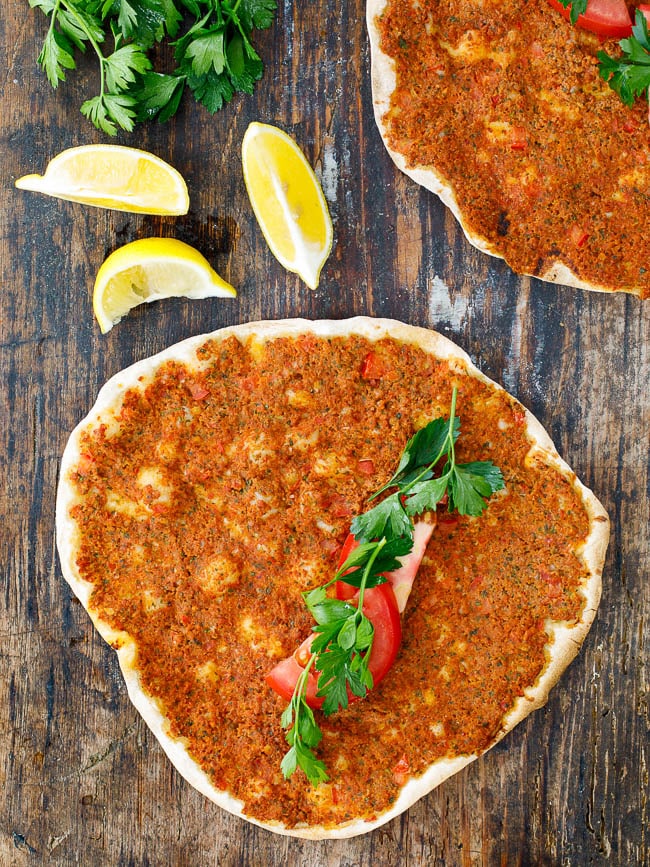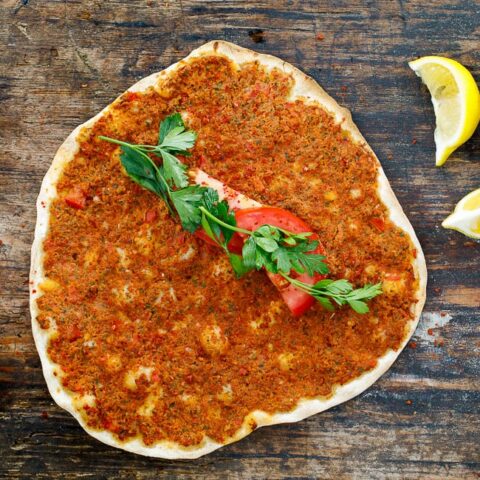Lahmacun: A Journey Through Turkish Flatbread Delight
Related Articles
- Elevate Your Breakfast With Japanese Tamagoyaki And Matcha Pancakes: A Culinary Journey To The Land Of The Rising Sun
- Chimichurri Steak: A Flavorful Journey Through Argentina
- A Deep Dive Into The World Of Ayam Goreng: Indonesia’s Beloved Fried Chicken
- A Deep Dive Into Pho Bo: Vietnam’s Soulful Noodle Soup
- A Culinary Journey Through Morocco: Unveiling The Secrets Of Tagine Cooking
Introduction
Welcome to our in-depth look at Lahmacun: A Journey Through Turkish Flatbread Delight
Lahmacun: A Journey Through Turkish Flatbread Delight

Lahmacun, often called "Turkish pizza," is a beloved street food and home-cooked staple in Turkey and beyond. This thin, crispy flatbread topped with a vibrant, savory meat mixture is a testament to the ingenuity and resourcefulness of Turkish cuisine. It’s a dish that effortlessly blends tradition with modern culinary techniques, offering a canvas for endless flavor combinations.
This article delves into the fascinating history of Lahmacun, explores the nuances of its preparation, and provides a comprehensive guide to crafting your own delicious versions. We’ll journey through the evolution of culinary techniques, discuss essential ingredients, and reveal the secrets to achieving that perfect, crispy crust.
A Culinary Time Machine: The History of Lahmacun
The origins of Lahmacun are shrouded in the mists of time, but its history is intricately woven into the cultural tapestry of the Middle East and Anatolia. While the exact birthplace remains a subject of debate, Lahmacun’s roots can be traced back to ancient civilizations, with evidence suggesting its presence in various forms throughout the region.
Ancient Roots:
- Mesopotamia: Archeological evidence suggests that flatbreads topped with various fillings, including meat and vegetables, were enjoyed in ancient Mesopotamia. This practice likely influenced the development of Lahmacun.
- Ottoman Empire: The Ottoman Empire, with its vast culinary traditions, played a crucial role in shaping Lahmacun. During this era, the dish gained popularity in the Anatolian region, where it was often served as a quick and satisfying meal.
- Modern Turkey: In modern Turkey, Lahmacun is an integral part of the culinary landscape. It’s a beloved street food, a staple in homes, and a frequent feature in restaurants across the country.

The Evolution of Lahmacun:
- Traditional Methods: Historically, Lahmacun was prepared using simple, readily available ingredients. The dough was often made with flour, water, and a pinch of salt, while the topping consisted of minced meat, onions, and spices.
- Modern Techniques: Over time, Lahmacun has evolved to incorporate a wider range of ingredients and culinary techniques. Modern variations often include ground meat, vegetables like peppers and tomatoes, and a variety of spices.
From Street Food to Global Phenomenon:
Lahmacun’s journey has taken it from humble street food stalls to the kitchens of renowned chefs around the world. Its adaptability and deliciousness have made it a global culinary phenomenon, capturing the hearts of food enthusiasts everywhere.
Understanding the Ingredients: A Culinary Symphony
Lahmacun is a symphony of flavors and textures, where each ingredient plays a crucial role in creating the final masterpiece.
The Dough:
The foundation of any great Lahmacun is its dough. This thin, crispy base serves as a canvas for the flavorful toppings.
- Flour: The choice of flour is crucial. High-protein flour, like bread flour, provides structure and elasticity, resulting in a dough that can stretch thin without tearing.
- Water: The amount of water used in the dough determines its texture. Too much water can make it sticky and difficult to work with, while too little can result in a dry and brittle dough.
- Salt: A pinch of salt enhances the flavor of the dough and helps to control yeast activity.
- Yeast: While not always used, yeast adds a slight tanginess and helps the dough rise, creating a slightly airy texture.

The Topping:
The topping is the heart and soul of Lahmacun, bringing a burst of flavor and texture to the dish.
- Meat: Traditionally, ground lamb is used, but ground beef, chicken, or a mixture of both can also be used. The meat is typically seasoned with a blend of spices, including cumin, paprika, and red pepper flakes.
- Onions: Onions are a staple ingredient in Lahmacun, adding a sweet and pungent flavor that complements the meat.
- Tomatoes: Diced tomatoes or tomato paste add a touch of sweetness and acidity to the topping.
- Green Peppers: Green peppers add a vibrant crunch and a hint of bitterness to the topping.
- Spices: A blend of spices, including cumin, paprika, red pepper flakes, and oregano, is used to create a complex and aromatic flavor profile.
- Olive Oil: Olive oil is drizzled over the topping, adding richness and flavor.
The Art of Crafting the Perfect Lahmacun
Now that we understand the building blocks of Lahmacun, let’s dive into the art of crafting this culinary masterpiece.
Preparing the Dough:
- Mix the Ingredients: Combine flour, salt, and yeast in a large bowl. Gradually add water, kneading until a smooth, elastic dough forms.
- Knead the Dough: Knead the dough for at least 10 minutes, until it becomes smooth and elastic.
- Rest the Dough: Place the dough in a lightly oiled bowl, cover it with plastic wrap, and let it rise in a warm place for about an hour, or until doubled in size.
- Shape the Dough: Once the dough has risen, punch it down and divide it into portions, depending on the desired size of your Lahmacun. Roll each portion into a thin, round shape.
Preparing the Topping:
- Sauté the Onions: In a large pan, sauté diced onions in olive oil until softened and slightly translucent.
- Brown the Meat: Add ground meat to the pan and cook until browned, breaking it up with a spoon.
- Add the Spices: Stir in cumin, paprika, red pepper flakes, and oregano.
- Add Tomatoes and Peppers: Stir in diced tomatoes and green peppers.
- Simmer and Season: Simmer the mixture for about 10 minutes, or until the vegetables are tender. Season with salt and pepper to taste.
Assembling the Lahmacun:
- Prepare the Baking Sheet: Preheat your oven to 450°F (230°C). Line a baking sheet with parchment paper.
- Spread the Topping: Place the rolled-out dough on the baking sheet. Spread the meat mixture evenly over the dough, leaving a small border around the edges.
- Bake the Lahmacun: Bake for 10-12 minutes, or until the crust is golden brown and crispy.
- Drizzle with Olive Oil: Remove the Lahmacun from the oven and drizzle it with olive oil.
Culinary Tips and Variations:
Tips for Success:
- Use Quality Ingredients: Using high-quality ingredients will result in a more flavorful and satisfying Lahmacun.
- Don’t Overcrowd the Pan: Give each Lahmacun enough space to cook evenly.
- Watch the Crust: Keep a close eye on the Lahmacun while it’s baking, as it can burn quickly.
- Serve Immediately: Lahmacun is best served fresh, as the crust will soften as it cools.
Variations on Lahmacun:
- Vegetarian Lahmacun: Replace the meat with a mixture of chickpeas, lentils, or vegetables.
- Spicy Lahmacun: Increase the amount of red pepper flakes for a spicier kick.
- Cheese Lahmacun: Sprinkle shredded cheese over the topping before baking.
- Lahmacun with Yogurt: Serve Lahmacun with a dollop of yogurt or a side of ayran (a Turkish yogurt drink).
Beyond the Plate: Lahmacun in Turkish Culture
Lahmacun is more than just a delicious dish; it’s a cultural icon in Turkey. It’s a symbol of family, tradition, and shared experiences.
- Street Food Staple: Lahmacun is a popular street food in Turkey, often sold by vendors who prepare it fresh in front of customers.
- Home-Cooked Comfort: It’s also a beloved home-cooked meal, enjoyed by families and friends alike.
- Social Gathering: Lahmacun is often served at social gatherings, such as birthday parties and weddings.
- Cultural Significance: It represents the ingenuity and resourcefulness of Turkish cuisine, using simple ingredients to create a flavorful and satisfying dish.
Conclusion: A Culinary Journey Continues
Lahmacun is a testament to the enduring power of food to bring people together. It’s a dish that has traveled through time, evolving and adapting to different cultures and palates.
Whether you’re enjoying it as a street food staple or crafting your own version at home, Lahmacun offers a culinary journey that is both delicious and culturally enriching. It’s a dish that invites you to explore the vibrant flavors of Turkish cuisine and experience the warmth of its cultural heritage.
Closure
Thank you for reading! Stay with us for more insights on Lahmacun: A Journey Through Turkish Flatbread Delight.
Don’t forget to check back for the latest news and updates on Lahmacun: A Journey Through Turkish Flatbread Delight!
Feel free to share your experience with Lahmacun: A Journey Through Turkish Flatbread Delight in the comment section.
Keep visiting our website for the latest trends and reviews.






